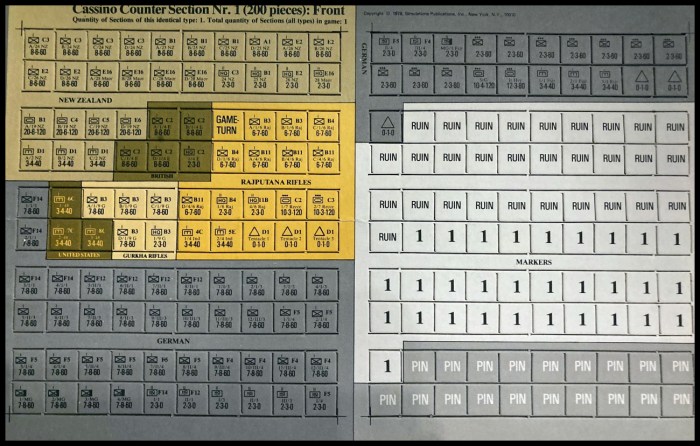Aaron Danis, 15 September 2022 ~ #UnboxingDay
The Battle for Cassino: Assaulting the Gustav Line, 1944 is a decidedly old magazine game from designer/developer John Prados for long-defunct SPI games. I recently reacquired a pristine unpunched version of the Strategy & Tactics #71 version of this game in a ziplock from eBay for a very fair price. I failed to solo on this game when I was 16 years old, and wanted to give it a second look, so this is the second time I have “unboxed” it.

click images to enlarge
This two-player game covers the March 1944 assault on the Abbey summit at the Grand Tactical level (mostly companies/ platoons for the Germans and companies (and two recce platoons) for the Allies. As Prados points out in the designer notes at the end of the rules, this was when the New Zealanders “reached to within a grenade’s throw of the Cassino Abbey” which was part of the Germans’ Gustav Line. The preponderance of the allied force is provided by the New Zealanders (27 units), with the Rajputana Rifles (17 units), British and Gurkhas (10 each), and Americans (3 engineering companies) providing the rest. The German forces consist of 43 units, for a total of 120 units out of 200 1/2-inch counters, the remainder being game markers like ruins and pins. The counters are thin and well-cut.

The game scale is 50 meters per hex and 6 hours per turn, which led to the unusually large movement allowances in the game (mostly 40/60/120 movement points – MPs – depending on unit type). I think this freaked me out at age 16, having been a veteran at that age of Panzer Blitz/Leader and other tactical games with much smaller movement allowances. It makes much more sense now, and the allowances don’t seem as large when you are an Allied unit trudging up to the Abbey paying up to 5 MPs per hex, or double that in ruins. Again, Prados provides the rationale in the designer notes for the large MPs. The game is 17 turns (15-19 March) and includes 8 night turns which have special rules (think Gurkha and German paratroop special assault bonuses).


The map sheet is nothing if not colorful. At 50 meters per hex in mountainous terrain, there is a lot of “up and down” movement under fire, but that is to be expected of almost any battle in the Italian theater of operations. Most notably (or infamously) there are EXTENSIVE line of sight (LoS) rules, to include the LoS eye-test chart shown in the photo below. You will want to photocopy that so you can “connect the dots” for direct and indirect fire determination. I think the LoS rules (not the Germans) were what ultimately defeated my 16-year old self from ever completing the game. They are not for the faint of heart; there is even a mathematical equation!

The game has a lot of “chrome” that should give you the feel for what it was like to refight this artillery-driven, close-in, grinding battle. It is attrition warfare at its best, and part of the reason that wargames on the Italian campaign are not more popular (as opposed to the sweeping desert warfare of North Africa only a year before). Prados’ accompanying S&T article does what this medium was designed to do: explain what happened and why, so you can put yourself in the adversaries’ shoes (I also recommend Rick Atkinson’s The Day of Battle).
A downer for this game is the grind of a lot of errata, which started with a last-second paper insert into the issue as it was originally mailed out in 1978 and that carried into S&Ts 72 and 73. On the upside there is a good tactical analysis of the battle published in Moves 45 (the source of all things SPI). The later boxed edition of the game incorporated all the known errata.
This version of the game I purchased is so clean that I actually feel bad that I am going to punch it out and play it. I believe, however, that every game was born to be played, not admired. FYI, Prados is a noted professor and author who has his own website where he gives thumbnail descriptions of his many games with interesting tidbits, Cassino included. It’s worth a visit. It’s also worth reading an interview with him in Moves #48 where he mentions how he thinks Cassino ranked at that time (a year after it was published) among his then game designs.

Thanks for joining this month’s #UnboxingDay with the Armchair Dragoons and we hope you enjoyed our look inside our latest acquisitions. You can always leave us your feedback in our #UnboxingDay thread, or in the comment area below.
You can find our regiment’s social media on Facebook, Twitter, and YouTube. (We have an Instagram page and we never use it.) We also have our Patreon, where you can support The Armchair Dragoons activities.
Feel free to talk back to us either in our discussion forum, or in the comments below.
WE USE COOKIES TO IMPROVE OUR PERFORMANCE
WE’RE NOT TALKING ABOUT THE SITE; WE’RE TALKING ABOUT THE STAFF
